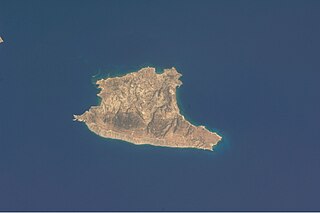
Gavdos is the southernmost Greek island, located to the south of its much larger neighbour, Crete, of which it is administratively a part, in the regional unit of Chania. It forms a community with surrounding islets and was part of the former Selino Province.
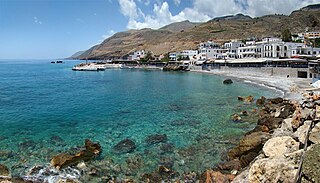
Hóra Sfakíon or Sfakia is a town on the south coast of Crete, Greece. It is the capital of the remote and mountainous region of Sfakiá, and is a small town of just 322 inhabitants. It lies on the south coast near the end of the Imbros Gorge, 74 km south of Chania. It has two small harbours, where the ferry boats from Agia Roumeli dock, which in the summer bring the hikers from the Samaria Gorge to take buses back to the northern coast. From Hóra Sfakíon ferries also go to the nearby coastal town of Loutro and the island Gavdos.

Palaiochora is a small town in Chania regional unit, Greece. It is located 70 km south of Chania, on the southwest coast of Crete and occupies a small peninsula 400 m wide and 700 m long. The town is set along 11 km of coastline bordering the Libyan Sea. It is the seat of the municipality of Kantanos–Selino and its population was 2,181 in the 2021 census.

Chania, also spelled Hania, is one of the four regional units of Crete; it covers the westernmost quarter of the island. Its capital is the city of Chania. Chania borders only one other regional unit: that of Rethymno to the east. The western part of Crete is bounded to the north by the Cretan Sea(part of the Aegean Sea) and to the west and south by the Mediterranean Sea and Libyan Sea. The regional unit also includes the southernmost island of Europe, Gavdos.

Platanias is a village and municipality on the Greek island of Crete. It is located about 10 km (6.2 mi) west from the city of Chania and east of Kissamos, on Chania Bay. The seat of the municipality is the village Gerani. Platanias is a popular tourism village with beaches, several hotels, restaurants, bars, nightclubs and souvenir shops. The area is especially popular with Scandinavian tourists with the season running from April to October. Not far from the coast is the island of Agioi Theodoroi.

East Selino is a former municipality in the Chania regional unit, Crete, Greece. Since the 2011 local government reform it is part of the municipality Kantanos-Selino, of which it is a municipal unit. The municipal unit has an area of 136.555 km2 (52.724 sq mi). It is situated on the south-west coast of the island of Crete. It was part of the former Selino Province which covered the mountain and coastal region west of Sfakia. The seat of the municipality was Kampanos.

Pelekanos is a former municipality in the Chania regional unit, Crete, Greece. Since the 2011 local government reform it is part of the municipality Kantanos-Selino, of which it is a municipal unit. The municipal unit has an area of 166.618 km2 (64.332 sq mi). Pelekanos is in the south west corner of the island, part of the rugged and remote Selino Province. The Venetians built a castle - Kastel Selinou - at Palaiochora, giving the region its name. Palaiochora is now a growing coastal resort and the capital town of the municipality.

Kissamos is a town and a municipality in the west of the island of Crete, Greece. It is part of the Chania regional unit and of the former Kissamos Province which covers the northwest corner of the island. The town of Kissamos is also known as Kastelli Kissamou and often known simply as Kastelli after the Venetian castle that was there. It is now a port and fishing harbour, with a regular ferry from the Peloponnese via Kythira. A town museum is located in the old Venetian governor's palace and there have been important archaeological finds in the town, including fine mosaics, dating from the Roman city of Kisamos. The head town of the municipality is Kastelli-Kissamos itself.

Kandanos or Kantanos, also Candanos, is a town and former municipality in the Chania regional unit, Crete, Greece. Since the 2011 local government reform it is part of the municipality Kantanos-Selino, of which it is a municipal unit. The municipal unit has an area of 73.081 km2 (28.217 sq mi). It was part of the former Selino Province which covered the southwest of the island. The community has 590 residents.

Sougia is a community and a small village in Chania regional unit on the island of Crete, Greece. It is part of the municipal unit of East Selino. It is located on the south coast of the island, 70 km south of Chania. The community consists of the following villages :
Epanochori is a community and a small village in Chania regional unit on the island of Crete, Greece. It is part of the municipal unit of East Selino. The community consists of the following villages :

The term Drosoulites refers to a long procession of visions, seen by residents around Frangokastello castle in Sfakia region of Crete (Greece). The phenomenon is rumored to be visible every year, on the anniversary of the Battle of Frangokastello or even in early June near a small village in southern Crete.
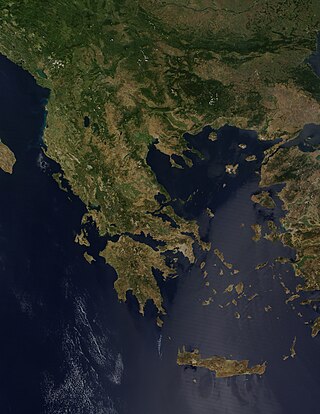
Greece is a country in Southeastern Europe, on the Balkan Peninsula. It is bordered to the north by Albania, North Macedonia and Bulgaria; to the east by Turkey, and is surrounded to the east by the Aegean Sea, to the south by the Cretan and the Libyan seas, and to the west by the Ionian Sea which separates Greece from Italy.

Hatzimichalis Dalianis was a revolutionary leader of the Greek War of Independence and commander in Crete in 1828.

Gavdopoula is a Greek islet in the Libyan Sea, north-west of its larger neighbour Gavdos and to the south of Crete. It is part of the municipality of Gavdos in the regional unit of Chania, Crete, and was part of the former Selino Province.

Elafonisi is an island located close to the southwestern corner of the Mediterranean island of Crete, of which it is administratively a part, in the municipality of Kissamos of the regional unit of Chania. When the weather is fine it is possible to walk to the island through the shallow water. The island is a protected nature reserve. It is known for its pink sand beaches, created by tidal and wave-induced deposits of pigmented microorganisms living in a symbiotic relationship with native seaweed.
Prasonisi, is a small islet off the southern coast of Crete, close to the northern coast of the island of Gavdos and between Gavdos and the islet of Gavdopoula, in the Libyan Sea. Administratively, it is located within the municipality of Gavdos, in Chania regional unit.

Kantanos-Selino is a municipality in Chania regional unit, Crete, Greece. It is numbered 4 on the map of the Chania region. The seat of the municipality is the village of Palaiochora. The municipality has an area of 376.254 km2 (145.272 sq mi). A significant number of fresco's painted by Ioannis Pagomenos are located in Selino.
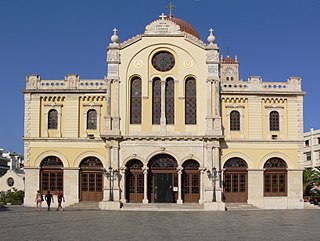
The Church of Crete is an Eastern Orthodox church, comprising the island of Crete in Greece. The Church of Crete is semi-autonomous (self-governing) under the jurisdiction of the Ecumenical Patriarchate of Constantinople. The current archbishop of Crete is Eugenios II.
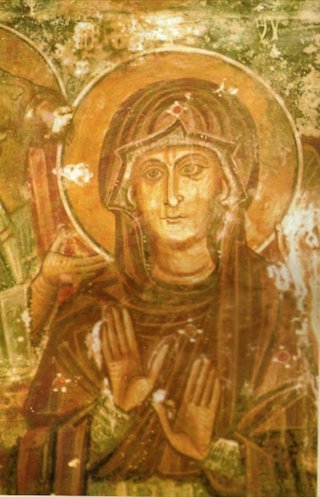
Ioannis Pagomenos was a Greek painter in the Byzantine style active in Venetian-ruled Crete. He created fresco cycles for rural Orthodox churches under commission from ordinary members of the local peasant communities, who acted as collective patrons. While he could be considered a forerunner to the Cretan School, which saw success in producing hybrid-style icons for an international clientele, his work was more traditional in character and only incorporated Western influences in secondary details, as it catered to regional tastes. His style nonetheless shows significant development over the years. His frescos survive in four districts of the Chania prefecture, with the majority in the mountainous province of Selino, which displays the highest density of church painting in Crete. His art influenced Andreas Pavias, Angelos Akotantos, Andreas Ritzos, and Nikolaos Tzafouris. By 1337/8 Pagomenos was working together with his son Nikolaos within the framework of a small family workshop of painters, other examples of which are known from contemporary Crete and the Aegean.

















